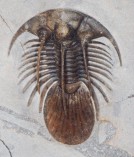 Click image
Click image |
Introduction: One of the most well-known and diverse groups of fossil arthropods belong to the class Trilobita and occur in Paleozoic rocks all over the world. They were already abundant in the mid-Cambrian (524 million years ago), reached their peak of diversity at the end of the Cambrian, and finally disappeared from the fossil record during the great Permian extinction (250 mya). Trilobite fossils are found worldwide, with many thousands of known species. Because they evolved rapidly, and moulted like other arthropods, trilobites serve as excellent index fossils, enabling geologists to date the age of the rocks in which they are found.
 Abundance: Trilobites are very well-known, and possibly the second-most famous fossil group after the dinosaurs. When trilobites appear in the fossil record of the Lower Cambrian they are already highly diverse and geographically dispersed. Because of their diversity and an easily fossilized exoskeleton, they left an extensive fossil record with some 17,000 known species spanning Paleozoic time. Trilobites have been important in biostratigraphy, paleontology, and plate tectonics research. For example, trilobites have been important in estimating the rate of speciation during the period known as the Cambrian Explosion because they are the most diverse group of metazoans known from the fossil record of the early Cambrian, and are readily distinguishable because of complex and well preserved morphologies. Abundance: Trilobites are very well-known, and possibly the second-most famous fossil group after the dinosaurs. When trilobites appear in the fossil record of the Lower Cambrian they are already highly diverse and geographically dispersed. Because of their diversity and an easily fossilized exoskeleton, they left an extensive fossil record with some 17,000 known species spanning Paleozoic time. Trilobites have been important in biostratigraphy, paleontology, and plate tectonics research. For example, trilobites have been important in estimating the rate of speciation during the period known as the Cambrian Explosion because they are the most diverse group of metazoans known from the fossil record of the early Cambrian, and are readily distinguishable because of complex and well preserved morphologies.
 Click image
Click image |
Ecology: Most trilobites lived in fairly shallow water and were benthic. They walked on the bottom, and probably fed on detritus. A few, like the agnostids, may have been pelagic, floating in the water column and feeding on plankton. Cambrian and Ordovician trilobites generally lived in shallow water. After the Ordovician, when many trilobite groups declined or went extinct, the survivors tended to be restricted to deeper water.
Food particles were stirred up by the legs and passed forward to the mouth. Since the mouth had no large mandibles, we infer that trilobites were not usually predatory and were restricted to soft food. Some trilobites had long spines on the first leg segment. These types may have been able to tear up larger pieces of food, and probably scavenged for a living. Fossil burrows and tracks have been found that match trilobite bodies very precisely; these show that trilobites could burrow into sediment to feed or to avoid predators. Many trilobites living after the Cambrian developed the ability to roll up, also probably as a defense against predators. Still other trilobites, particularly the family Olenidae, are thought to have evolved a symbiotic relationship with sulfur-eating bacteria from which they derived food.
|

